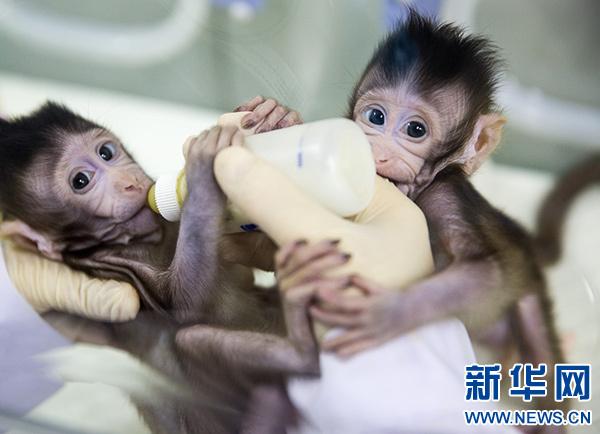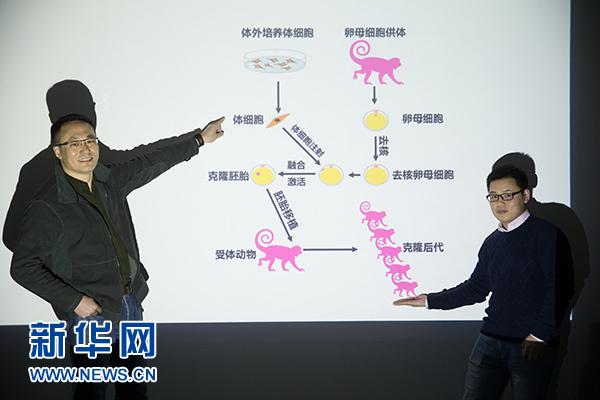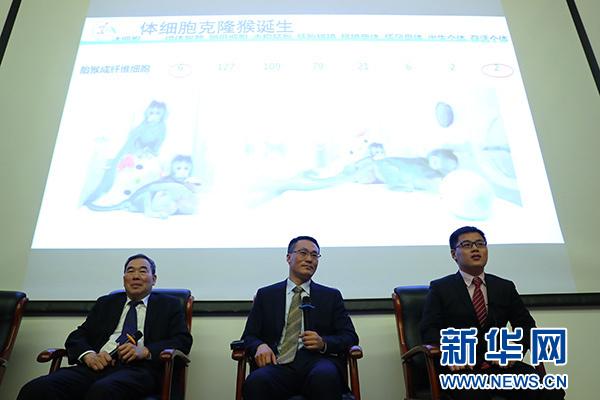The cloned monkey succeeded in China.
The Chinese Academy of Sciences announced that the world's first somatic cell clone monkey "Zhongzhong" was born on November 27, 2017, and the second cloned monkey "Huahua" was born 10 days later. The international authoritative academic journal "Cell" published the results online in the form of a cover article on January 25th, Beijing time.
Since the birth of the first cloned sheep, Dolly, in 1996, scientists have used human cells to clone cattle, rats, cats, dogs and other animals for 21 years, but have never crossed the non-human primates that are closest to humans. The "barrier".
Why is it difficult to clone a monkey? What is the value of its birth? With these questions, the reporter interviewed the research team for the first time at the birthplace of the cloned monkey, the non-human primate platform of the Institute of Neuroscience of the Chinese Academy of Sciences.

The cloned monkeys "Zhongzhong" and "Huahua" were carefully taken care of in the incubator of the non-human primate platform nursery of the Institute of Neuroscience of the Chinese Academy of Sciences (photo taken on January 22). Xinhua News Agency reporter Jin Liwang photo
What is the value of a cloned monkey? Disease research, new drug testing will greatly speed up
After the physical examination, the reporter put on a mask and put on a white coat. Under the leadership of Sun Qiang, a researcher at the Institute of Neurology of the Chinese Academy of Sciences, he walked into the “baby room†of the cloned monkey baby.
The world's first cloned monkey "ä¸ä¸", and her sister "Huahua" are playing in the incubator. My sister is 10 days older than her sister. Apart from the slight difference in size, the sisters can't see any difference.
Both of their genes are from the female fetus of the same abortion. The researchers extracted the somatic cells (non-germ cells) of this macaque fetus and “implanted†their nuclei by technical means into several egg cells that “extracted†the nucleus. “Zhongzhong†was the first lucky person to develop and be born smoothly.
What does the birth of a cloned monkey mean?
“It means that China will take the lead in establishing an animal model that can effectively simulate human diseases.†Sun Qiang said that with the use of cloning technology, a large number of model monkeys with the same genetic background can be cultivated in one year. This can meet the urgent needs of brain disease and advanced brain cognitive function research, and can be widely used in new drug testing.
Sun Qiang said that if the genetic background of the subjects is different, the "experimental group" and the "control group" will not be strong enough. Mice have been used extensively in traditional medical experiments, largely because rodents can produce a large number of very similar mice by rapid inbreeding.
However, because mice and humans are too far apart, drugs developed for mice are mostly ineffective or have side effects when tested in humans. It is understood that this is one of the main reasons why most brain disease research cannot make breakthroughs.
Academician Pu Muming, director of the Institute of Neurology of the Chinese Academy of Sciences, said that the success of cloning monkeys will bring unprecedented bright prospects for the research, intervention, diagnosis and treatment of diseases such as brain diseases, immune defects, tumors and metabolism. "This is a major breakthrough in the world of life sciences in recent years," he said.

This is Sun Qiang, a researcher at the Institute of Neuroscience, Chinese Academy of Sciences (left) and Dr. Liu Zhen (photo taken on January 21). Xinhua News Agency reporter Jin Liwang photo
Why is it so hard to clone a monkey? Three difficulties raise the threshold
From the first cloned sheep to the first cloned monkey, it took 21 years. During the period, scientists from various countries have cloned cattle, rats, pigs, cats, dogs and other animals, but they have been unable to do anything about monkeys.
In 2003, the authoritative academic journal Science published a paper by a researcher at the University of Pittsburgh School of Medicine. The paper said that cloning primates with existing technology "is not feasible."
The closest successful experiment occurred in 2010. The famous scientist Mitali Popov of the Oregon Persian Research Center led a team to successfully transplant cloned monkey embryos, but the embryos developed to 81 days and ended in abortion.
Sun Qiang introduced that there are three main difficulties in cloning monkeys. One of the problems is that the nuclear nuclei are not easy to identify, and it is difficult to "nuclearize". As the recipient's egg cell, the nucleus must be "extracted" in order to accommodate the "nuclear" of the somatic cell's nucleus. However, the monkey's egg cell nuclear denucleation is very difficult.
In the Sun Qiang team, postdoctoral Liu Zhen is the main operator of “going to the nuclearâ€. With the help of microscopic equipment, Liu Zhen used a pair of skillful hands to practice repeatedly, and completed the “nuclearization†work with the minimum loss in the shortest time, laying an important foundation for the subsequent cloning work.
The second problem is that egg cells are easily activated in advance. During the cloning process, when the nucleus of a somatic cell enters an egg cell, it is necessary to "awake" the egg cell before starting a series of developmental "programs." Therefore, the timing of the “wake up†is very precise. However, in the traditional way, the monkey's egg cells are easily "wake up" in advance, often resulting in the clone "program" not starting properly.
The third problem is that the developmental efficiency of somatic cell cloned embryos is low. The nucleus that has been transferred to the egg cell suddenly plays the role of fertilized egg. The "catch the duck on the shelf" is very unsuitable, and scientists need to take various measures to "escort." If the "protection" is not effective, most of the cloned embryos are difficult to develop normally, and often die in the womb.
After five years of unremitting efforts, Sun Qiang team successfully broke through the problem of the world's biological frontiers of cloned monkeys. Through DNA fingerprinting, the nuclear genome information of "Zhongzhong" and "Huahua" is completely consistent with the donor somatic cells, which proves that both sisters are authentic cloned monkeys.

On January 24th, Academician Pu Muming, Sun Qiang, and Dr. Liu Zhen (left to right), director of the Institute of Neuroscience of the Chinese Academy of Sciences, held a press conference in Beijing. Xinhua News Agency reporter Zhang Yuwei photo
What do you do after cloning a monkey? Not considering related research on humans
"The only purpose of cloning non-human primates is to serve human health, but researchers do not consider conducting research on humans," Pu Muming said.
Scientists believe that because monkeys and humans are very similar in genetics, cloning monkey research will greatly promote the development of new therapies for the treatment of human diseases.
"This is also the key technology of the 'big brain mesoscopic neural connection map' international big science plan." Pu Muming said that China is currently in the international leading position in this field, and will further make China a gathering place for brain science talents in the world.
Bai Chunli, president of the Chinese Academy of Sciences, said that in addition to its significant significance in basic research, this achievement will also promote China's pioneering development of a new pharmaceutical R&D industrial chain based on animal models of non-human primate diseases, in response to China's population health Challenge to contribute.
(Source: Xinhuanet)
Puyang Linshi Medical Supplies Co., Ltd. , https://www.linshimedicals.com